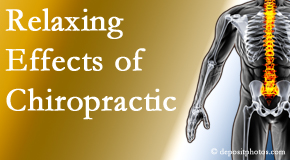Satterwhite Chiropractic Offers Treatment with Relaxing Effects
Where does your stress go? Neck? Upper back? Head? Low back? Would you like some help relaxing? Chiropractic spinal manipulation may well produce relaxing effects particularly when applied to the cervical and thoracic spine areas. Satterwhite Chiropractic observes stress every day. Satterwhite Chiropractic hears our Oxford chiropractic patients request more spine treatment once they feel it! Wise chiropractic patients!
MEASURING RESPONSES TO SPINAL MANIPULATION: STRESS
First, how do we respond to stress? Sweaty palms. Rapid pulse and heart rate. We can feel these responses. Researchers want to quantify these responses. Measuring heart rate variability, blood pressure, heart rate, and numeric pain scale after treating upper and lower cervical spine segments of healthy and neck pain patients, researchers found that upper cervical manipulation boosted parasympathetic (calming) system and lower cervical manipulation improved sympathetic (fight or flight) activity. Interestingly, neck pain patients’ parasympathetic activity was improved by both upper and lower cervical manipulation. (1) Satterwhite Chiropractic notes that just the effect of touch is influential.
EFFECTS OF MANIPULATION ON STRESS RESPONSES
The body responds to all types of stimuli. Researchers attempt to document how. One group performed a meta-analysis of multiple studies regarding the effect of spinal manipulation and mobilization on cardiovascular responses. Changes in systolic blood pressure, diastolic blood pressure and heart rate were charted. They determined that spinal manipulation and mobilization may bring about a significant decrease of systolic together with diastolic blood pressure. (2) An analysis of articles about the effect of spinal manipulation on heart rate variability reported that a larger parasympathetic response was noted when cervical and lumbar spine areas were treated while a larger sympathetic response was noticed when the thoracic spine was treated. (3) Another study linked pain response to resting blood pressure pre- and post-cervical spine non-thrust manipulation. Non-chronic neck pain patients who underwent such manipulation had reduced short-term pain and reduced systolic blood pressure. (4) There’s something to manipulation beyond pain relief, and Satterwhite Chiropractic is thrilled to present the research as it is made available.
SPINAL MANIPULATION TREATMENT
Satterwhite Chiropractic utilizes gentle spinal manipulation applied to the cervical, thoracic and lumbar spine areas to reduce pain. Spinal manipulation of the thoracic spine effectively influences painful mechanical thoracic spine pain better than placebo treatment. (5) Effects of thoracic manipulation transcend the thoracic spine. Advantages of manipulation of the thoracic spine extend to the cervical spine for patients with bilateral chronic mechanical neck pain. Thoracic thrust manipulation and non-thrust mobilization produce similar changes in patients’ pressure pain thresholds and reduce neck pain intensity. (6) These are benefits of Oxford chiropractic care Satterwhite Chiropractic is well-experienced to deliver.
CONTACT Satterwhite Chiropractic
Listen to this PODCAST with Dr. James Cox on The Back Doctors Podcast with Dr. Michael Johnson as he explains how chiropractic and The Cox® Technic System of Spinal Pain Management may well attune parasympathetic and sympathetic as well as pain responses in the body.
Make your next Oxford chiropractic appointment now. Your neck and shoulders and upper back will appreciate the attention as will your reduced pain and heart rate and blood pressure after a gentle Oxford spinal manipulation session.

